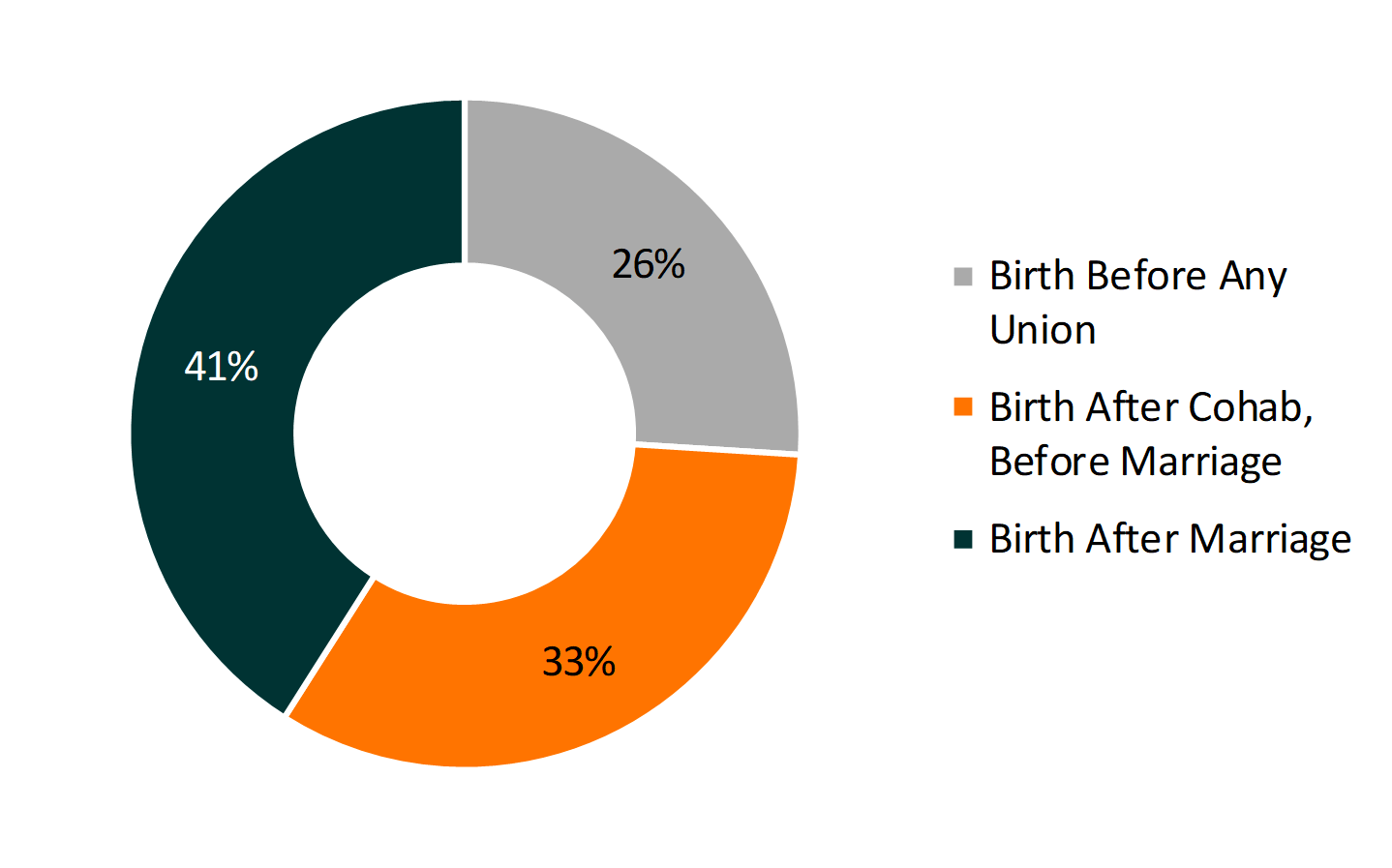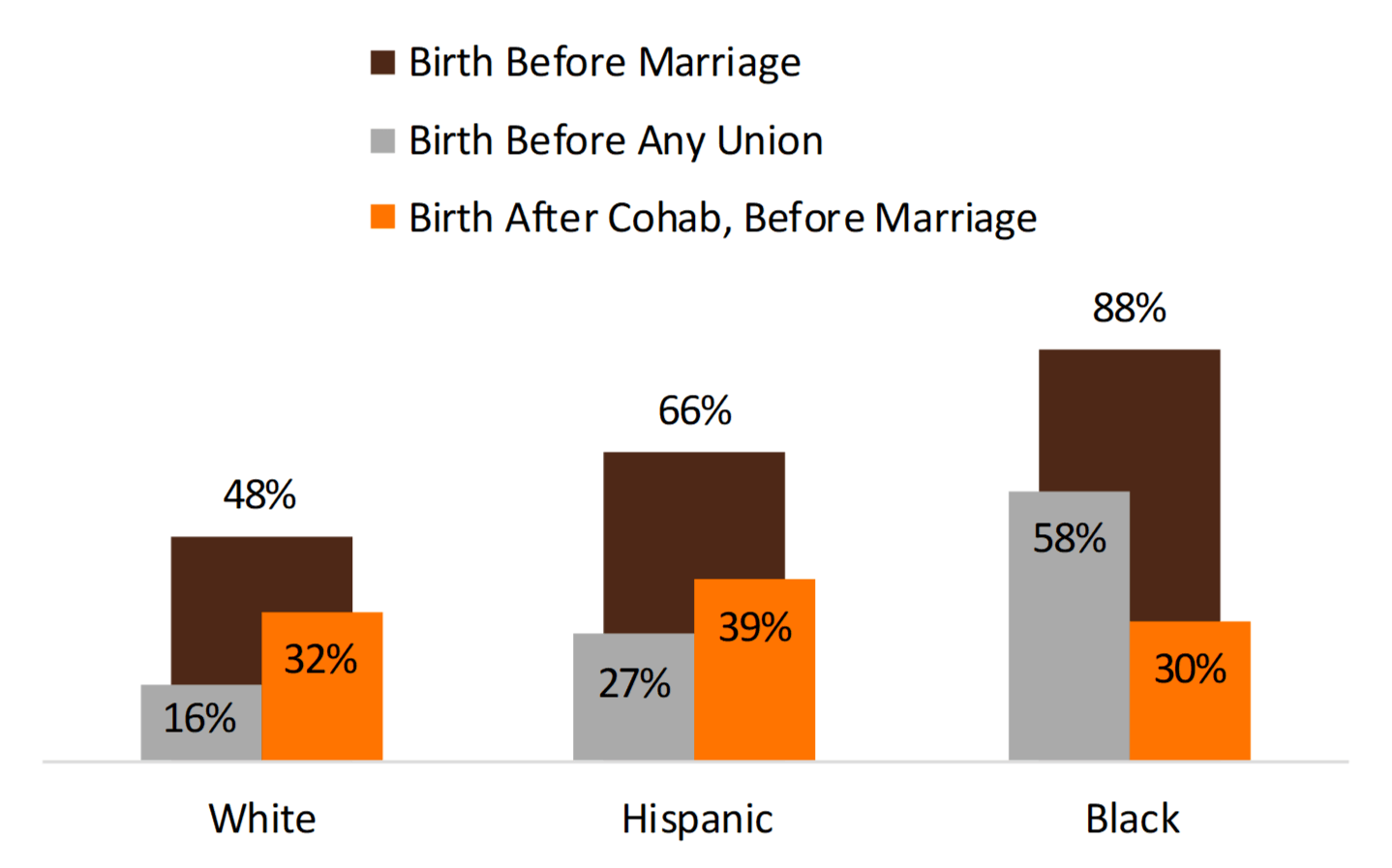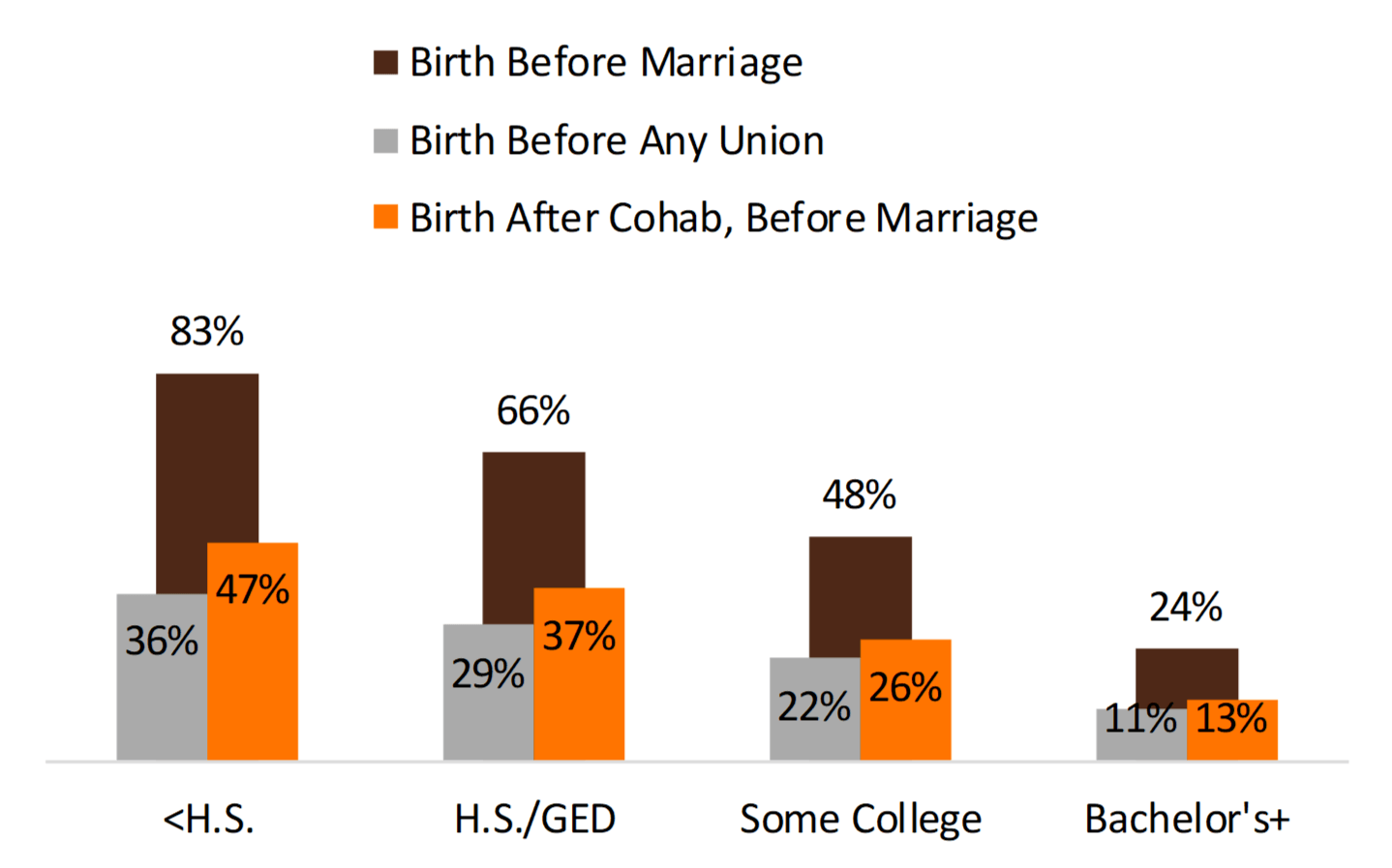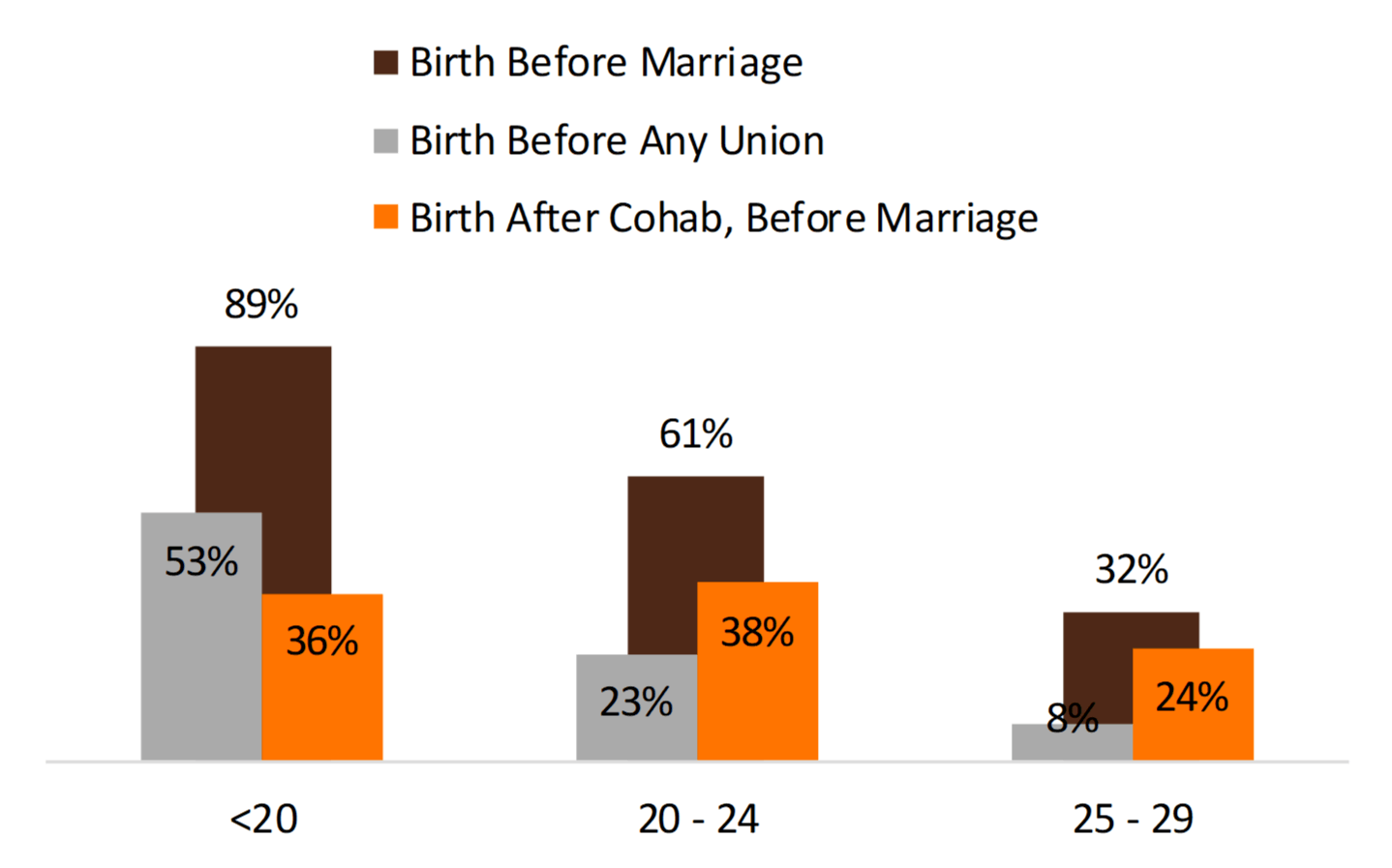Young Adulthood: Sequencing of Union Experiences Relative to First Birth

Family Profile No. 24, 2018
Author: Paul Hemez
Most contemporary men and women experience a family formation event (i.e., cohabiting, marrying, or having a child) during their young adult years. Among those born between 1980 and 1984, for example, 62% of men and women cohabited, 45% married and 50% became parents by their 30th birthday (FP-18-22). However, the sequencing of events varies. The transition to parenthood relative to union formation is of particular interest as the link between marriage and parenthood has weakened (Hayford, Guzzo, & Smock, 2014), and the median age at first birth is younger than the median age at first marriage (FP-17-22). Using the first 17 rounds of the National Longitudinal Survey of Youth 1997, this Family Profile focuses on those who had a first birth by age 30. It also considers differences in the coresidential union experiences of men and women at the time they became parents, examining variation across race/ethnicity, educational attainment, and age at first birth. Estimates represent the experiences of young adults born between 1980 and 1984 and refer to the sequencing of family formation events. In other words, the estimates do not necessarily represent the union context in which first births occurred.
Union Experience Relative to First Birth
Three in five (59%) young adult parents had their first child before ever getting married.
- Among men and women who became parents by age 30, slightly more than one-quarter had a child before experiencing either a cohabitation or a marriage.
- One-third of those who first had a birth during their young adult years did so after having cohabited but before experiencing a marriage.
Figure 1. Distribution of the Sequencing of First Births Relative to Union Formation, by Age 30

Race/Ethnicity
Sharp racial/ethnic differences exist in the share of parents who entered parenthood prior to marriage.
- Among those with a birth by age 30, about half (48%) of White young adult parents had their first child before they married, whereas two-thirds of Hispanic and 88% of Black young adults had not married before becoming parents.
- The race/ethnicity gap is most evident among parents who had a child before entering a coresidential union. One in six Whites who had a birth prior to age 30 did so before they experienced any coresidential union compared to more than one-quarter (27%) of Hispanics and 58% of Blacks.
- Similar shares of White and Black young adult parents had their first child before marriage but after cohabiting, 32% and 30% respectively.
Figure 2. Percentage of Young Adults’ First Birth that Occurred Before Marriage, by Race/Ethnicity

Educational Attainment
The share of young adults’ first births that occurred before marriage or cohabitation follows a strong educational gradient. The vast majority (83%) of young adult parents with less than a high school degree had their first child prior to any union formation, whereas one-quarter (24%) of young adult parents with a college degree entered parenthood prior to marrying or cohabiting.
- Among men and women who became parents before their 30th birthday, experiencing a first birth before any coresidential union was three times as common for those with less than a high school degree than those with a Bachelor’s degree or more (36% vs. 11%).
- Becoming a parent after having cohabited but before marriage was also three times as common for young adults with less than a high school degree than those with at least a Bachelor’s degree (47% vs. 13%).
Figure 3. Percentage of Young Adults’ First Birth that Occurred Before a Marriage, by Educational Attainment

Age at First Birth
The share of young adult parents who entered parenthood prior to marriage or cohabitation was greatest among those who entered parenthood at younger ages. Nine in ten (89%) teenage parents had their child prior to marriage, and one- third of older parents (ages 25-29) did so.
- Among those who became parents by age 20, about half (53%) gave birth before forming any union compared to just 8% of those who became parents between the ages of 25 and 29.
- Similar shares of young adults who became a parent before age 20 and between the ages of 20-24 entered parenthood after having cohabited but before experiencing a marriage (36% and 38%, respectively).
Figure 4. Percentage of Young Adults’ First Birth that Occurred Before a Marriage, by Age

Data Source
- Bureau of Labor Statistics, U.S. Department of Labor. (2017). National Longitudinal Survey of Youth 1997 cohort, 1997-2015 (rounds 1-17). Produced by the National Opinion Research Center, the University of Chicago and distributed by the Center for Human Resource Research, The Ohio State University. Columbus, OH.
References
- Eickmeyer, K. J., Payne, K. K., Brown, S. L., & Manning, W. D. (2017). Crossover in the median age at first marriage and first birth: Thirty-Five years of change. Family Profiles, FP-17-22. Bowling Green, OH: National Center for Family & Marriage Research. https://www.bgsu.edu/ncfmr/resources/data/family- profiles/eickmeyer-payne-brown-manning-crossover-age-first-marriage-birth-fp-17-22.html
- Hayford, S., Guzzo, K. B., & Smock, P. J. (2014). The decoupling of marriage and parenthood? Trends in the timing of marital first births, 1945-2002. Journal of Marriage and Family, 76(3), 520-538. doi: 10.1111/jmof.12114
- Hemez, P. (2018). Family formation during young adulthood: Birth, marriage, and cohabitation experiences. Family Profiles, FP-18-22. Bowling Green, OH: National Center for Family & Marriage Research. https://doi.org/10.25035/ncfmr/fp-18-22
Suggested Citation
- Hemez, P. (2018). Young adulthood: Sequencing of union experiences relative to first birth. Family Profiles, FP-18-24. Bowling Green, OH: National Center for Family & Marriage Research. https://doi.org/10.25035/ncfmr/fp-18-24.
Updated: 11/07/2025 04:13PM


